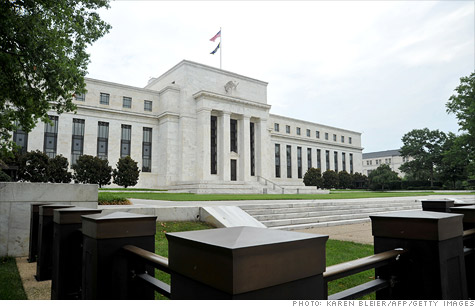Search News

The Federal Reserve proposes banks should hold more in capital buffers.
WASHINGTON (CNNMoney) -- The Federal Reserve on Thursday proposed tough new rules to require banks to hold even more in reserves as a capital buffer to better withstand future financial crises.
Wall Street has been watching the rulemaking on capital buffers closely. Requirements about capital cushions can directly impact banks' ability to lend, make financial bets and profit off those loans or bets.
Tougher capital cushions are also a key step toward making banks safer and avoiding future taxpayer bailouts.
"Pre-crisis capital requirements were too low in general," said Federal Board Reserve Board governor Daniel Tarullo at a meeting Thursday.
The rules would require banks to keep 7% of risk-weighted assets -- the loans banks make judged by the degree of risk involved -- aside. Banks would have until 2019 to meet the new rules.
For 20 banks with more than $250 billion in total assets, the rules would be a little tougher -- 3% of all assets, including "off-balance sheet exposures" such as derivatives, would have to be kept off limits as a leverage ratio. The provision would affect all the major megabanks, including JP Morgan Chase (JPM, Fortune 500), Bank of America (BAC, Fortune 500) and Citibank (C, Fortune 500), among others.
Derivatives are the risky bets that helped lead to the financial crisis of 2008.
The new rules are drawn from a 2010 deal negotiated with foreign nations, part of the so-called Basel III accords, requiring all banks to put more capital aside for emergencies.
Capital cushions have come under scrutiny again, in light of revelations that JPMorgan Chase lost $2 billion in bad bets made earlier this year and disclosed last month.
"This should improve the overall resiliency of the banking system," according to a memo on the new capital cushion rules released by the Fed.
Additionally, the Fed released new details on what qualifies as capital -- guidelines that are tougher than current standards -- the central bank notes.
Federal Reserve staff said that roughly 80% of banks already meet the tougher buffer of 7% of risk-weighted assets. They calculated that $3.6 billion would need to be raised to meet the new criteria.
The proposed rule will be voted on by the Federal Reserve Board and then faces 90 days of public comment. Then the Fed and other federal regulatory agencies would officially approve it later this year. The rules would be phased in starting in January 2013.
During a Senate Banking Committee hearing Wednesday, bank regulators said that all U.S. banks were safer than they were three years ago.
JPMorgan Chase has a capital cushion of $101 billion, compared to $1.8 trillion in assets, said its regulator, Comptroller of the Currency Thomas Curry. That's about 5.6% of all assets.
But JPMorgan will likely have to set even more capital aside under the new rules. That's because the proposed rules do not address an additional and controversial capital cushion that the largest U.S. banks may also have to meet. That rule could raise the required buffer at some banks from the new standard of 7% to as high as 9.5% of risk-weighted assets.
The Federal Reserve is expected to tackle that issue later.
| Overnight Avg Rate | Latest | Change | Last Week |
|---|---|---|---|
| 30 yr fixed | 3.80% | 3.88% | |
| 15 yr fixed | 3.20% | 3.23% | |
| 5/1 ARM | 3.84% | 3.88% | |
| 30 yr refi | 3.82% | 3.93% | |
| 15 yr refi | 3.20% | 3.23% |
Today's featured rates:
| Latest Report | Next Update |
|---|---|
| Home prices | Aug 28 |
| Consumer confidence | Aug 28 |
| GDP | Aug 29 |
| Manufacturing (ISM) | Sept 4 |
| Jobs | Sept 7 |
| Inflation (CPI) | Sept 14 |
| Retail sales | Sept 14 |